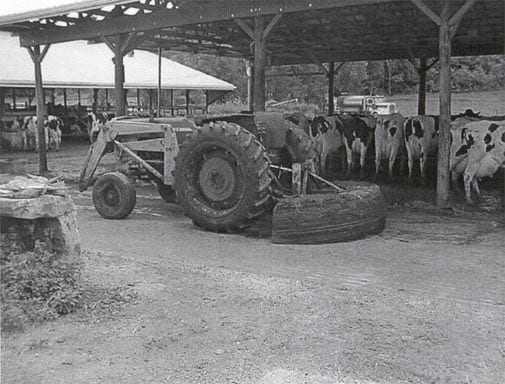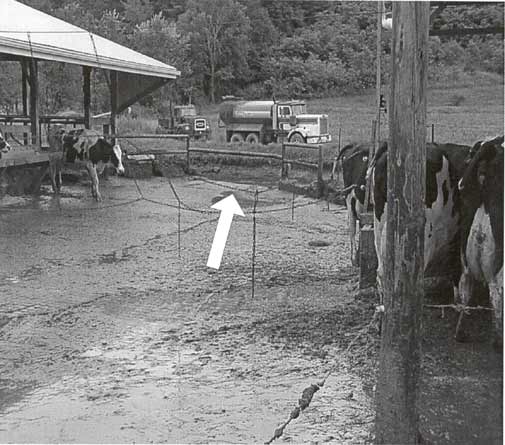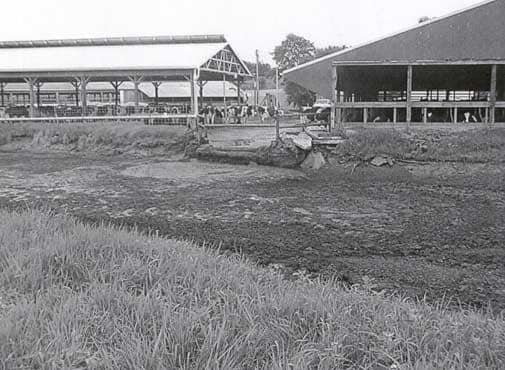A 15-Year-Old Male Farm Laborer Dies After the Tractor He was Operating Overturned Into a Manure Pit - Pennsylvania
NIOSH In-house FACE Report 2000-18
Summary
A 15-year-old male farm worker (the victim) died after the tractor he was operating overturned into a manure pit. The tractor was equipped with a manure scraper fashioned from half a tractor tire mounted on the draw bar at the rear of the tractor. The victim and another 15-year-old-male, who was sitting on the tractor’s left fender, were scraping cattle manure across a concrete-surfaced barnyard toward the mouth of the manure pit. As the tractor approached the open mouth of the manure pit, the victim applied the brakes, and the tractor skidded on the concrete surface wet from the manure. The left front wheel slid over the concrete edge of the manure pit, causing the tractor to overturn into the manure pit. The tractor came to rest upside down, pinning the victim underneath. The victim and the tractor were completely submerged in the manure pit. The passenger was able to reach the dirt side wall of the pit, climb out, and run for help. Other farm workers immediately called 911 and went to assist the victim. The local Fire Department and rescue personnel arrived within minutes and started to search for the victim. Approximately 35 minutes after the incident, the victim was extracted from the manure pit. Rescue personnel initiated CPR immediately and transported the victim to a local hospital where he was pronounced dead on arrival.
NIOSH investigators concluded that to help prevent similar occurrences, employers in agricultural operations should:
- ensure that manure pits are marked as hazardous areas and are substantially barricaded, as determined by the design of the pit, to prevent inadvertent entrance
- consider seeking the assistance of their local county extension agent, an agricultural engineer, or equipment dealers or manufacturers to ensure that attachments for machinery fabricated on the farm do not compromise safe operation of the machine
- ensure compliance with all Department of Labor Child Labor Laws, rules and regulations regarding employment of youths in agriculture
- assess the tasks assigned to youths and ensure that youths are properly trained to perform these tasks
- ensure that passengers are prohibited from riding on tractors
Additionally:
- Parents should discuss the types of work their children are performing and become familiar with the occupations and conditions of work that are prohibited for minors.
Introduction
On May 10, 2000, a 15-year-old male farm worker (the victim) died when the tractor he was operating overturned into a manure pit. A second 15-year-old male, who was riding on the fender of the tractor, was able to exit the manure pit uninjured. On June 5, 2000, officials of the Wage and Hour Division of the Department of Labor notified the Division of Safety Research (DSR) of this fatality. On July 27, 2000, a DSR occupational safety and health specialist conducted an investigation of the incident. The incident was reviewed with officials of the Wage and Hour Division of the Department of Labor who had investigated the incident. The State Police Station Commander was interviewed and the investigating trooper’s report was reviewed. A visit was made to the scene of the incident by the DSR investigator, where an interview with the farmer/employer was conducted and photographs taken.
The employer was a family-owned dairy farm that had been in operation under the present ownership for approximately 1 year. The farm had been in existence for 25 years. The employer had no written safety program or procedures. Any training by the employer was conducted on the job. On the day of the incident six workers were employed at the farm; three were under the age of 16. Neither of the 15-year-old males involved in the incident had received any formal training in the operation of the tractor involved in the incident. The victim had received some on-the-job training during the 1 year he had worked part time at the farm. The passenger involved in the incident had just begun work at the farm and was receiving on-the-job training from the victim at the time of the incident.
Back to Top
Investigation
In the late afternoon of May 5, 2000, two 15-year-old-male farm workers were using a tractor to scrape cattle manure across a concrete barn floor and yard area to the open mouth of a manure pit. The manure pit measured 50 yards long by 30 yards wide. The pit was 12 feet deep at its deepest point and approximately 10 feet deep in the area around the open-mouth entrance. A single strand of barbed wire was present around the perimeter of the manure pit.
The employer had fabricated the manure scraper from half a tractor tire and mounted it on the draw bar at the rear of the tractor. The open side of the half tractor tire faced the rear of the tractor (Picture 1). The tractor was driven forward to scrape up the manure and gather it into a pile at the mouth of the pit (Picture 2). The tractor was then turned around and backed up, pushing the manure over the edge of the concrete surface and into the pit. The 45-PTO (power take-off) horsepower tractor involved in the incident was approximately 30 years old and had a wide-front tire configuration. The tractor was not equipped with a rollover protective structure (ROPS).
At approximately 5:45 p.m., the victim was driving the tractor forward toward the unguarded mouth of the manure pit. The second male was riding as a passenger on the tractor, sitting and holding onto the left-hand fender. As the victim applied the tractor’s brakes in an attempt to slow down, the tractor skidded across the concrete surface wet from the manure. The left front wheel slipped over the concrete edge at the mouth of the manure pit, causing the tractor to overturn into the pit. The tractor came to rest upside down completely submerged, pinning the victim in the manure pit (Picture 3). The passenger was able to jump away from the tractor and exit the manure pit by way of its dirt side embankment and run for help. The emergency rescue service was called and other farmhands came to assist the victim. Fire Department and rescue personnel responded within minutes and started searching for the tractor and the victim. Rescue workers stated that the manure had a viscosity similar to that of freshly poured cement, and this ruled out the use of scuba divers in the search for the victim. The rescue workers stood in approximately 4½ feet of manure probing with poles and hooks in an effort to locate the victim and tractor. Approximately 35 minutes after the incident, the victim was located and extracted from the manure pit. Rescue personnel initiated cardiopulmonary resuscitation (CPR) immediately and transported the victim to a nearby hospital where he was pronounced dead on arrival.
Back to Top
Cause of Death
The Medical Examiner listed the cause of death as asphyxia.
Recommendations and Discussion
Recommendation #1: Employers involved in agricultural operations should ensure that manure pits are marked as hazardous areas and are substantially barricaded, as determined by the design of the pit, to prevent inadvertent entrance.
Discussion: Manure pits are necessary on larger farming operations to serve as holding facilities until such time as the manure can be dispensed to other areas of the farm as liquid fertilizer. The open pit in this incident was located at the end of a concrete yard that ran between two cattle barns. Manure holding facilities can also be configured as underground pits located outside or under barns, or as silo-type configurations. All manure holding facilities should be marked and identified as hazardous areas, and should be substantially barricaded to prevent inadvertent entrance to the pits. Farm owners and operators should periodically inspect manure pits on their farms to ensure these safety measures are in place. All employees should be made aware of the hazards associated with manure pits, including drowning, oxygen deficient and/or explosive atmospheres due to the presence of methane, and hazardous atmospheres due to hydrogen sulfide.
In this instance, the open pit was barricaded around its perimeter by a single strand of barbed wire that was not sufficient to stop the tractor from entering the manure pit. Farm owners and operators should consider seeking the assistance of their local county extension agent, an agricultural engineer, or equipment dealers or manufacturers in evaluating the safest way to barricade their manure holding facilities. In this instance, steel beams or iron pipes could have been set in the concrete runway to provide a more substantial barricade. Additionally, the runway could have been extended over the end of the pit. An opening could have been located in the runway over the pit that would be large enough to allow the manure to drop into the pit but not large enough to impede the tractor’s operation. A buffer area could have been located behind the opening in the runway with the barricade set at the end of the buffer area.
Recommendation #2: Employers involved in agricultural operations should consider seeking the assistance of their local county extension agent, an agricultural engineer, or equipment dealers or manufacturers to ensure that attachments for machinery fabricated on the farm do not compromise the safety of the machine or the machine operator.
Discussion: In this instance, the employer was using a manure scraper fabricated from half a tractor tire mounted on the draw bar on the rear of the tractor. This made it necessary for the operator to turn to the left and right while crossing in front of the face of the manure pit, which may have increased the likelihood of the tractor skidding. It may have been possible to mount the half tire on the draw bar in the opposite direction so that the manure could have been pushed into the pit without a turn being necessary. It might also have been possible for a longer draw bar to have been used that would have allowed the operator to push the manure into the pit from a safer distance. Alternatively, mounting the half tire or a blade on a longer draw bar on the front of the tractor would have allowed the operator to approach the manure pit moving forward with a clearer view of the pit instead of having to turn his torso while backing.
Recommendation #3: Employers involved in agricultural operations should ensure compliance with all Department of Labor Child Labor Laws, rules and regulations regarding employment of youths working in agriculture.
Discussion: By law, youths under the age of 16 employed in agriculture are limited in the types of equipment they can operate and the environments they are allowed to work in and around. Agricultural Hazardous Order 8 prohibits youths under the age of 16 from working in and around manure pits under any circumstances. Additionally, Agricultural Hazardous Order (HO) 1 prohibits youths ages 14 and 15 from operating a tractor over 20 PTO horsepower. An exception is made if they are family members or if they have received formal training in a tractor driving safety course from a 4-H, FFA, or some other approved federal extension program. In this incident, the youth was driving a tractor that exceeded the Department of Labor’s limit of 20 PTO horsepower.
Recommendation #4: Employers involved in agricultural operations should assess the tasks assigned to youths and ensure that they are properly trained to perform these tasks.
Discussion: The victim had received only on-the-job training in operating the tractor involved in the incident and had never received formal training on tractor operation. The slippery surface caused by the manure may have presented a hazard the youth did not have the experience to identify or control. Employers involved in agricultural operations should assess tasks assigned to workers and assign the more difficult tasks, such as operating machinery, to only the most experienced employees. Additionally, the owner stated during the investigation that the victim was training the passenger. Employers should ensure that young workers receive safety courses from the 4-H, FFA, or some other approved federal extension program, and that they are supervised by experienced workers while performing their duties.
Recommendation #5: Employers involved in agricultural operations should ensure that passengers are prohibited from riding on tractors.
Discussion: The 15-year-old passenger in this incident was sitting on, and holding onto, the fender of the tractor. Though not a factor in this incident, it allowed for the possibility that he could have lost his balance due to a sudden turn or bump. This also exposed the passenger to the hazards associated with the manure pit. Agricultural Hazardous Order 7 prohibits youths less than 16 years of age from riding on a tractor as a passenger or helper. Employers should instruct workers that no passengers should be on equipment and ensure that workers comply with these instructions.
Recommendation #6: Parents should discuss the type of work their children are performing and become familiar with the occupations which are prohibited for minors.
Discussion: Parents can learn more about the types of agricultural work prohibited for 14-and 15 year-olds by reviewing the references provided in this report.1, 2 When parents are aware of the age-specific types of work that are prohibited under Child Labor Laws, they will be better able to assist their children in making appropriate employment decisions. Once their children are employed, parents should communicate regularly with their children about their work and should be prepared to intervene if they have concerns about their safety and health.
References
- DOL [1990]. Child labor requirements in agriculture under the Fair Labor Standards Act. (Child Labor Bulletin No. 102). Washington, D.C.: U.S. Department of Labor, Employment Standards Administration, Wage and Hour Division, WH 1295.
- Department of Labor, Wage and Hour Division web site: http://www.dol.gov/whd/external icon. (Link Updated 3/14/2013)
- NIOSH [1990]. NIOSH Alert : Preventing Deaths of Farm Workers in Manure Pits. Cincinnati, OH: U.S. Department of Health and Human Services, Public Health Service, Centers for Disease Control and Prevention, National Institute for Occupational Safety and Health, DHHS, (NIOSH) Publication No. 90-103.
Back to Top
Photographs

|

|

|
The FACE investigation project is the cornerstone of the overall NIOSH program to prevent occupational fatalities. The objectives for this effort include the investigation of occupational fatalities to assess and characterize the circumstances of these events in order to develop succinct descriptive and evaluative reports for distribution to occupational safety and health groups across the country. This work is being conducted by the FACE investigation team. It is expected that the reports alone will have a major impact by better defining the causal factors behind occupational fatalities, calling national attention to the problem, and providing insights into the prevention efforts that are needed. However, the program does not determine fault or place blame on companies or individual workers.
